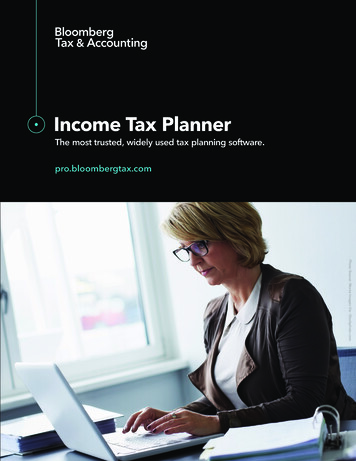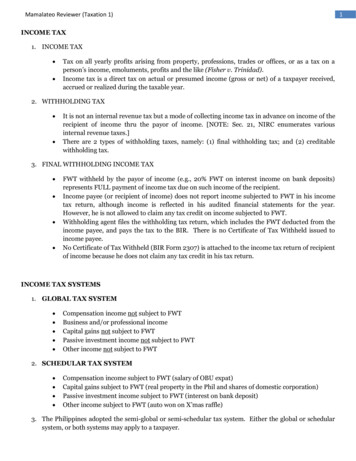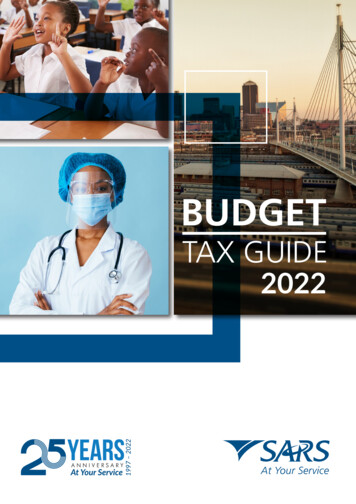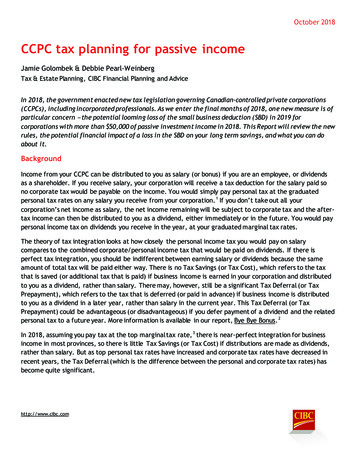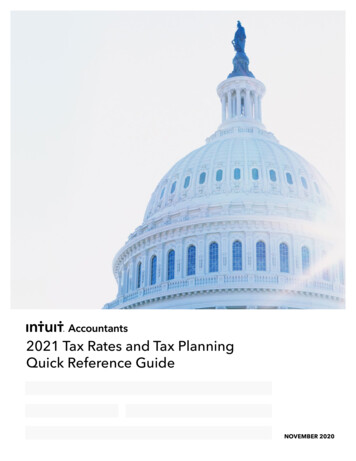
Transcription
Individual incometax planningWith the potential for tax reform on the horizon, your peripheralview may include glimpses of changes in individual income taxrates or deductions. However, as you consider individual incometax planning matters, your current goals and objectives need tobe front and center. Do not let the potential for tax reform distractyou from what is in plain view, because those distractions may turnout to be very costly.Now is the time for you to take another look at tax planning foryour 2017 and 2018 individual tax matters. Concentrate your viewon planning that is available to you today, based on current law,with an eye toward what issues and opportunities tax reformmay create for you tomorrow. This will lead you down the path torealizing a more tax-efficient result for you and your family.Back12018 essential tax and wealth planning guide Forward
Individual income tax planningToday’s increased tax rate environmentToday’s increased taxrate environmentLook again at currenttax rates by type ofincomeIndividual income taxrates by type of incomeThere are three lenses throughwhich we can look again at individualincome tax planning. First, we canexamine how today’s increased taxrate environment came to be. Thisgives perspective on how rates havediffered for various types of incomeover the years. Then we can examinethe current tax environment and howyou can plan for potential incomerecognition or timing of controllabledeductions. Finally, we can examinepossibilities for tax reform and howthat may reframe the picture oftax planning.It has been said that the tax tailshould not wag the dog. What thatmeans is that though our tax ratestructure has evolved over the pasttwo decades, your investment andfinancial goals should remain frontand center to create the best view foryour tax planning. Within that viewthough, there are certain planningopportunities that are unique tothe current tax environment andshould not be overlooked due tothe potential for tax reform. Thepotential for reform should notparalyze planning, but shouldcompel it. Failing to acknowledgepotential tax issues means thatyou could have a less efficient taxresult. As the potential for tax reformevolves, what you truly need tounderstand are the planning optionsthat exist based on your uniqueoverall financial view.Increased individual income taxrate environment: Look again athow we got hereAs you will see in the following chart,significant changes to individualincome tax rates have occurred ina relatively short period of time.This has included both increasingtax rates for ordinary income andcapital gains, along with adjusting thephaseout of itemized deductions.Each shift has affected the optionsavailable for planning. At times, itmay also have shifted your financialobjectives by examining the incomeor deductions to which a particularinvestment may give rise. Therefore,we will briefly explain how the existingincreased individual income tax rateenvironment came to be.Self-employment taxAlternative minimumtax (AMT)Health care taxesState and foreign taxesLook again: Year-roundpersonalized planningYear-roundpersonalized planningPlanning forlong-term gainsPlanning forcharitablecontributionsBack22018 essential tax and wealth planning guide Forward
Individual income tax planningToday’s increased tax rate environmentToday’s increased taxrate environmentLook again at currenttax rates by type ofincomeIndividual income taxrates by type of income2013Patient Protection andAffordable Care Act (PPACA)passed 2010, effective 20132012American TaxpayerRelief Act of 2012 (ATRA)2010Tax Relief, Unemployment InsuranceReauthorization, and Job CreationAct of 2010 (TRUIRJCA)2003Jobs and Growth TaxRelief ReconciliationAct of 2003 (JGTRRA)2001Economic Growth and TaxRelief Reconciliation Actof 2001 (EGTRRA)32018 essential tax and wealth planning guide Self-employment tax While passed in 2010, the PPACA imposed the following taxes, effective as of January 1, 2013, fortaxpayers with adjusted gross income (AGI) over the applicable threshold ( 200,000 for singlefilers)/ 250,000 for married filing joint):–– 3.8 percent net investment income tax (NIIT) on the net investment income of individuals, estates,and trusts–– 0.9 percent increase (from 1.45 percent to 2.35 percent) on the employee share of Medicare taxesimposed on earned income by the Federal Insurance Contributions Act Hospital Insurance (FICA-HI)Alternative minimumtax (AMT) Permanently extended the reduced tax rates for lower- and middle-income taxpayers, but allowed thetop tax rates to increase and return to pre-EGTRRA levels for upper-income taxpayers Permanently increased the top rate on income from capital gains and qualified dividends to 20 percent Permanently extended the limitation on itemized deductions, commonly known as the Pease limitationand the personal exemption phaseout (PEP), for single taxpayers with AGI over 250,000, or 300,000 formarried filing jointly (MFJ) filers Permanently indexed the alternative minimum tax (AMT) exemption amount to inflation to eliminatethe needs for an annual patchLook again: Year-roundpersonalized planning Extended the fully phased-in EGTRRA rate reductions and repealed the Pease and PEP limitations for twoadditional years, through 2012 Extended the JGTRRA changes with respect to capital gain and dividend income for two additional yearsHealth care taxesState and foreign taxesYear-roundpersonalized planningPlanning forlong-term gainsPlanning forcharitablecontributions Accelerated certain tax changes passed under EGTRRA Lowered from tax rate on dividends and capital gains Increased the exemption amount for the individual AMT Phased in a reduction in ordinary and capital gains tax rates over nine years Phased out the Pease limitation and PEP Created the concept of qualified dividends with a preferential tax rate Sunset provision of EGTRRA meant as of January 1, 2011, everything would revert back topre-EGTRRA levelsBackForward
Individual income tax planningToday’s increased taxrate environmentLook again at current taxrates by type of incomeLook again at currenttax rates by type ofincomeIndividual income taxrates by type of incomeSelf-employment taxNow that we have briefly examined how the current increasedincome tax environment came to be, we will discuss the variousrate components based on the type of income being taxed.Categories of incomeOrdinary incomeQualified dividendsCapital gainsCategories of taxIncome taxSelf-employmentAlternative minimum tax (AMT)Health care taxesState and foreign taxesOrdinary income tax ratesIf your primary source of incomecomes from employment, thenyou will generate ordinary incomein the form of wages, salaries, tips,commissions, bonuses, and othertypes of compensation. Otherinvestments may also generateordinary income in the form ofinterest, nonqualified dividends, netincome from a sole proprietorship,partnership or limited liabilitycompany (LLC), rents, royalties, orgambling winnings. For 2017 (and2018), the top marginal ordinaryincome tax rate is 39.6 percentfor single taxpayers with incomemore than 418,400 ( 426,700) andmarried taxpayers with income morethan 470,700 ( 480,050). Ordinarytax rates continue to range from10 percent to 39.6 percent and willremain in place permanently untilfurther reform.Tax rates on qualified dividendsWe will refer to qualified dividendincome as tax preferential incomesince the top qualified dividend rateis 20 percent for taxpayers in thetop 39.6 percent bracket. This is incontrast to the 39.6 percent toprate assessed on ordinary income.For taxpayers in the 25 percentthrough 35 percent ordinary incometax brackets, the top rate on theirqualified dividend income is 15percent. For those taxpayers in thetwo lowest ordinary income taxbrackets, their qualified dividend rateis zero percent. Note that in additionto these rates, qualified dividendsmay also be subject to the 3.8percent NIIT.Alternative minimumtax (AMT)Health care taxesLong-term capital gains tax ratesIf you have invested in a capital asset,then the gain on the sale or exchangeof such an asset results in capital gain.The long-term capital gains tax rate,assessed on capital assets held forgreater than one year, is 20 percentfor taxpayers in the top 39.6 percenttax bracket, 15 percent for taxpayersin the 25 percent through 35 percenttax brackets, and zero percent forthose taxpayers in the two lowest taxbrackets. Given the reduced rates onlong-term capital gains, we will alsorefer to this income as tax preferentialincome.State and foreign taxesLook again: Year-roundpersonalized planningYear-roundpersonalized planningPlanning forlong-term gainsPlanning forcharitablecontributionsBack42018 essential tax and wealth planning guide Forward
Individual income tax planningToday’s increased taxrate environmentIndividual income taxrates by type of incomeGiven the tax preferential nature of long-termcapital gain income, special attention should begiven to the holding period of an asset to take fulladvantage of the long-term capital gain rates.Certain sales of capital assets do not qualify for thelower capital gains rate. A short-term capital gain—or gain on the sale of an asset held for one year orless—is still a capital gain, but is taxed at ordinaryincome tax rates. Although short-termcapital gains are taxed at the same rate as ordinaryincome, a benefit to short-term capital gains isthat they can be offset with capital losses since anindividual will net his or her capital gains and lossesin arriving at their total capital gain income. Notethat if capital losses exceed capital gains, a taxpayercan only deduct up to 3,000 of net capital lossesagainst other income—the balance of their netcapital loss is to be carried forward to future years.Look again at currenttax rates by type ofincomeIndividual income taxrates by type of incomeGains from installment sales are taxed at the ratein effect on the date an installment payment isreceived. Collectibles remain subject to a 28 percentmaximum rate.It is important to remember that more than onetype of tax may apply to the same character ofincome. Therefore, we will now discuss additionaltaxes that may apply, including employment taxes,AMT, and NIIT.Self-employment taxAlternative minimumtax (AMT)Health care taxesState and foreign taxesLook again: Year-roundpersonalized planningYear-roundpersonalized planningHolding periodPlanning forlong-term gainsShort term1 year or lessYear0Planning forcharitablecontributionsYear1Long termMore than 1 year52018 essential tax and wealth planning guide Year2BackForward
Individual income tax planningToday’s increased tax rate environmentToday’s increased taxrate environmentLook again at currenttax rates by type ofincomeIndividual income taxrates by type of incomeSelf-employment tax2017 and 2018 federal income tax bracketsAlternative minimumtax (AMT)Individual income tax rates 2017Taxable incomeSinglePPACA taxesMarried filing jointOrdinary income 0– 9,325 0– 18,65010%over 9,325– 37,950over 18,650– 75,90015%over 37,950– 91,900over 75,900– 153,10025%over 91,900– 191,650over 153,100– 233,35028%over 191,650– 416,700over 233,350– 416,70033%over 416,700– 418,400over 416,700– 470,70035%over 418,400over 470,70039.6%Capital gainsNIITFICA-HIUnearned incomeEarned income0%15%if AGI is over 200,00 single/ 250,000 MFJ3.8%0.9%20%PPACA taxesTaxable incomeMarried filing joint 0– 9,525 0– 19,05010%over 9,525– 38,700over 19,050– 77,40015%over 38,700– 93,700over 77,400– 156,15025%over 93,700– 195,450over 156,150– 237,95028%over 195,450– 424,950over 237,950– 424,95033%over 424,950– 426,700over 425,950– 480,05035%over 426,700over 480,050Ordinary income39.6%Capital gainsState and foreign taxesLook again: Year-roundpersonalized planningIndividual income tax rates 2018SingleHealth care taxesNIITFICA-HIUnearned incomeEarned incomeYear-roundpersonalized planningPlanning forlong-term gainsPlanning forcharitablecontributions0%15%if AGI is over 200,000 single/ 250,000 MFJ3.8%0.9%20%Back62018 essential tax and wealth planning guide Forward
Individual income tax planningToday’s increased taxrate environmentSelf-employment taxLook again at currenttax rates by type ofincomeIndividual income taxrates by type of incomeIf your income is generated by operating a business as asole proprietor, a partner in a partnership, or a memberof a multimember LLC, you usually are subject to selfemployment tax in addition to your ordinary income tax.The self-employment tax rate is 12.4 percent for SocialSecurity tax on self-employment income up to 127,200for 2017 ( 128,700 for 2018) and 2.9 percent for Medicaretaxes on all self-employment income. These taxes are inaddition to the FICA-HI tax. Once self-employment tax hasbeen calculated, then half of that amount is deductiblewhen calculating overall AGI for that year.Self-employment taxSelf-employment taxes vs. FICA taxesFICA2017 base2018 baseEmployee rate Employer rateTotalAlternative minimumtax (AMT)Health care taxesSocial Security 127,200 .45%1.45%2.90%Look again: Year-roundpersonalized planning0.90%N/A0.90%Year-roundpersonalized planning16.20%Planning forlong-term gainsFICA-HITotal 200,000 single 200,000 single 250,000 MFJ 250,000 MFJ8.55%7.65%State and foreign taxesPlanning forcharitablecontributionsBack72018 essential tax and wealth planning guide Forward
Individual income tax planningAlternative minimum tax (AMT)Today’s increased taxrate environmentLook again at currenttax rates by type ofincomeIndividual income taxrates by type of incomeThe AMT has evolved into an unwieldy system thatcontinues to ensnare millions of unsuspectingtaxpayers and, as a result, the repeal of AMT isfrequently debated as part of potential tax reform.AMT is imposed at a nearly flat rate on an adjustedamount of taxable income above a certainthreshold, which is also known as an exemption.The exemption is substantially higher than theexemption from regular income tax. The AMTexemption is indexed for inflation and phased outas taxpayers reach higher levels of AMT income.For 2017 (and 2018), the AMT exemption amountfor single filers is 54,300 ( 55,400) and beginsto phase out at 120,700 ( 123,100). It is 84,500( 86,200) for MFJ filers, for whom the exemptionbegins to phase out at 160,900 ( 164,100).income taxes (especially in states with high rates),prepayment of investment and tax adviser fees, andcharitable contributions. Falling victim to AMT hasmany possible causes, but you may be particularlyprone to AMT if you have any of the followingcircumstances:Large state and/or local income, sales tax,or property tax deductionsLarge long-term capital gains or qualifieddividendsLarge deductions for accelerateddepreciationLarge miscellaneous itemized deductionsAn exercise of incentive stock optionsThe ability to apply most nonrefundable personalcredits (including the Dependent Care Credit,the credit for the elderly and disabled, the creditfor interest on certain home mortgages, and theHope Education Credit) against the AMT expiredat the end of 2011, but was reinstated again on apermanent basis as part of ATRA.Now that the difference between the highestordinary income tax rate and the highest AMTrate has increased, as has the AMT exemption, itis likely that fewer taxpayers will be subject to AMTgoing forward. Still, in order to navigate the AMT,taxpayers must be especially mindful of year-endcash payments, such as fourth-quarter state82018 essential tax and wealth planning guide Large amounts of tax-exempt incomethat is not exempt for state tax purposesA large number of dependentsTax-exempt income from privateactivity bondsCurrent-year planning aroundtiming of the payment ofexpenses that constituteitemized deductions notdeductible under the AMTsystem is certainly important,but it may not be enough. Inaddition, projecting taxableincome from hedge andprivate equity funds, as well asmanaging private activity bonds,are among activities that takeon special significance. Morethan ever, meaningful AMTplanning requires examiningmulti-year scenarios.Self-employment taxAlternative minimumtax (AMT)Health care taxesState and foreign taxesLook again: Year-roundpersonalized planningYear-roundpersonalized planningPlanning forlong-term gainsPlanning forcharitablecontributionsMineral investments generating percentagedepletion and intangible drilling costsResearch and development expensesin activities in which you do notmaterially participateBackForward
Individual income tax planningToday’s increased taxrate environmentHealth care taxesLook again at currenttax rates by type ofincomeIndividual income taxrates by type of incomeSelf-employment taxAs we have previously discussed the creation of the heath care taxes, it is nowimportant to put the taxes in the context of how they apply to particular typesof income. Note that each of these taxes are in addition to other taxes that areassessed on these types of income.NIITNIITAn additional 3.8 percent NIIT is imposed onunearned income, such as interest, dividends,capital gains, annuities, royalties, rents, and incomefrom businesses in which the taxpayer does notactively participate (income not earned froma trade or business and income subject to thepassive activity rules).Because the tax applies to gross income fromthese sources, income that is excluded from grossNIITsuch as tax-exempt interest, will not beincome,taxed. The tax is applied against the lesser3.8%Atax leviedNIITon certain unearned incomeindividualswith AGI3.8percenttaxoverlevied on certain unearnedAof 200,000( 250,000 forMFJAGIfilers).incomeo f individualswithover 200,000( 250,000 for MFJ filers).Net investment incomemeansthe excessof themofthegrossNetinvestmentincome sumeansexcessfromfollowingofincomethe sumof theg rossincomeoverfrom the following estAnnuitiesDividendsRents and royaltiesCapitalgainsPassive activities andtrading partnershipsessentialand wealth planning guide Does2018NOTapplytaxto:Wages3.8%ofnet investment income (afterA the taxpayer’stax leviedinvestment-relatedallowable deductions)on certain unearned andincomeormodified AGIexcessof individualswithinAGIover of the thresholdamounts.These thresholdsare set at 200,000 200,000 ( 250,000for MFJ filers).for single filers and 250,000 for MFJ filers.Someinvestmenttypes of income incomeare exempt from the tax,Netincludingincomefromin which themeans the excess of the businessessum of grosstaxpayeractivelyparticipates,incomefromthe followingover gains from thedispositionof certain active partnerships andallowabledeductions:S corporations, distributions from qualified plansInterestAnnuitiesand individual retirement accounts, wages, andDividendsRents androyaltiesany itemtaken into accountin determiningself-employmentincome.CapitalPassive activities andgainstrading partnershipsDoes NOT apply to:WagesAlternative minimumtax (AMT)Health care taxesState and foreign taxesFICA-HI taxAn additional 0.9 percent FICA-HI tax applies toearnings of self-employed individuals or wagesof an employee received in excess of 200,000( 250,000 if MFJ). Self-employed individuals willnot be permitted to deduct any portion of theadditional tax. If a self-employed individual also haswage income, then the threshold above which theadditional tax is imposed will be reduced by theamount of wages taken into account in determiningthe taxpayer’s liability.Look again: Year-roundpersonalized planningYear-roundpersonalized planningPlanning forlong-term gainsPlanning forcharitablecontributionsFICA-HI taxEmployee share increases by 0.9 percent(2.35 percent, up from 1.45 percent) for anindividual’s wages, compensation, or selfemployment income that exceeds thresholdamount for filing status:Self-employmentincomeDistributions fromqualified plansIncome that is derived inthe ordinary course of atrade or business and nottreated as a passive activityMFJMarried filingseparatelySingle 250,000 125,000 200,000Self-employed individuals are not permitted todeduct any portion of the additional tax.This change does not change the employerhospital insurance contribution.BackForward
Individual income tax planningToday’s increased taxrate environmentHealth care taxesLook again at currenttax rates by type ofincomeIndividual income taxrates by type of incomeSelf-employment taxConsider the example of married taxpayers who earn 750,000 in wages.Additionally, their investment income consists of 250,000 of interestand dividends and 1,000,000 of capital gains, with properly allocabledeductions of 70,000, for total net investment income of 930,000.Their total additional taxes under the PPACA is 39,840.Alternative minimumtax (AMT)Health care taxesState and foreign taxesLook again: Year-roundpersonalized planningMarried taxpayers, filing jointlyType and amount of income 750,000WagesApplicablePPACA taxApplicablethresholdIncome subject toapplicable PPACA taxTax rateAdditional taxFICA-HI( 250,000) 500,0000.90% 4,500Investment incomeInterest/DividendsCapital gainsProperlyallocable deductionsNet investment incomeYear-roundpersonalized planningPlanning forlong-term gainsPlanning forcharitablecontributions 250,000 1,000,000( 70,000) 1,180,000Net investmentincome tax (NIIT)Total additional tax( 250,000) 930,0003.80% 35,340 39,840Back102018 essential tax and wealth planning guide Forward
Individual income tax planningToday’s increased taxrate environmentState and foreign taxesLook again at currenttax rates by type ofincomeIndividual income taxrates by type of incomeHaving worked our way through the various federal taxesthat can be assessed, there are still income taxes fromother jurisdictions to be addressed. While a thoroughdiscussion of all possible taxes imposed by states orforeign countries is not the purpose here, no income taxplanning exercise is complete without considering thepotential for taxes from all possible jurisdictions.States such as Florida, Nevada, South Dakota,Texas, Washington, and Wyoming do not have individualincome taxes, but most states do—with California havingthe highest rate of more than 13 percent. If an individualis subject to income taxes in multiple states, it may bepossible to generate a state tax credit in the resident stateto reduce the overall tax burden.Individual consumers may also be subject to sales anduse taxes. When the governing body collects the tax atthe point of purchase, it is called a sales tax. Alternatively,when a tax on goods or services is paid to a governingbody directly by a consumer, it is usually called a usetax. The imposition of these taxes may be an importantconsideration when an investment is a commodity, such asan airplane or art.Finally, if income is earned in a foreign jurisdiction, thenit may be subject to foreign taxes. Similar to the state taxcredit, a foreign tax credit may be available when income issubject to tax in multiple jurisdictions.Self-employment taxHow high are income tax rates in your state?Top state marginal individual income tax rates as of July 1, 2017Alternative minimumtax (AMT)Health care taxesState and foreign O4.63%NM4.9%ND2.9%Look again: Year-roundpersonalized 8%MI4.25%IL4.95%MO6.0%AR6.9%IN3.23%KY6.0%MSAL5.0% %VT8.95%Planning forcharitablecontributionsNH 5.0%LA6.0%MA 12.0%FLAKPlanning forlong-term gainsPA3.07%OH4.997%TN 4.0%Year-roundpersonalized planningNY8.82%RI5.99%CT6.99%NJ8.97%DE6.6%MD 5.75%DC8.95%Back112018 essential tax and wealth planning guide Forward
Individual income tax planningToday’s increased taxrate environmentLook again: Year-roundpersonalized planningWith a solid understanding of the various taxesthat may be assessed on your income and theimportance of planning for this meaningful liability,you are now equipped to look again at the issuesthat are presented to you based on your personaltax situation. When we say considerations, we liketo think of those as levers that you can engage.What lever can you pullthat may position youfor a potentially moretax-efficient result?Considering the potential for a decrease in youroverall tax rate, maybe your lever is to take stepsto defer income to a subsequent year. Similarly,considering the potential changes to itemizeddeductions, maybe your lever is to accelerate adeduction or expense into the current year. Eitherway, think of these levers as tools within yourcontrol that you can use to affect your tax result.By implementing a long-term commitment toholistic tax planning, you likely will identify manydifferent levers to consider each year and positionyourself to navigate today’s increased tax rateenvironment more efficiently.To be more effective in your efforts, it is bestto not think of your tax situation based on theincome you expect to realize or the deductions youexpect to incur. To only think of income planningapproaches or deduction planning strategies is tothink in a vacuum. That is not the way that it workswhen you file your taxes—everything is taken intoconsideration when calculating your tax bill. Sowe encourage you to think of planning here as ayear-round process, taking into consideration all thelevers you can pull, be they income or deductiondecisions—to create a more efficient tax result.As you think about this, keep in mind that thelevers you will consider will be different than leverssomeone else would consider because each of ushas a unique tax posture and different goals andobjectives. There is no one-size-fits-all approachthat applies to everybody. You should focus onyour planning based on your own specific factpattern and objectives. Even if your income postureis identical to someone else’s, maybe you arecharitably inclined and they are not. Perhaps bothof you are charitably inclined, but you plan to fundyour charitable donations soon whereas the otherperson plans to fund his or her donations as part ofan estate plan. So your levers become very specificand unique to you based on your tax posture andyour personal goals and objectives.Look again at currenttax rates by type ofincomeIndividual income taxrates by type of incomeUnderstanding this is critical in tax planningbecause it shines a direct light on specificconsiderations for tax efficiencies for you andfacilitates the pursuit of your goals and objectives.As part of your long-term commitment to holistictax planning, recognize that each year may presentdifferent issues that motivate you to look again atyour goals based on that specific year’s activity. Forexample, maybe this year you have a significantordinary income event, but you expect a significantlong-term capital gain event next year. Maybethis year you expect an operating loss from yourbusiness enterprise, but next year you project thebusiness to turn around and be highly profitable.Obviously, the likelihood of anticipated legislativechanges will also need to be considered.Self-employment taxAlternative minimumtax (AMT)Health care taxesState and foreign taxesLook again: Year-roundpersonalized planningYear-roundpersonalized planningPlanning forlong-term gainsPlanning forcharitablecontributionsBack122018 essential tax and wealth planning guide Forward
Individual income tax planningYear-round personalized planningToday’s increased taxrate environmentLook again at currenttax rates by type ofincomeIndividual income taxrates by type of incomeTo start to think about this in more detail, weencourage you to consider the character and thetiming of your income and your deductions, as notall items of income or deductions are equal. Asreviewed earlier, some income, like wages, is subjectto ordinary tax rates as high as 39.6 percent. Otherincome, like long-term capital gains or qualifieddividend income, is subject to tax preferential ratesthat only go as high as 20 percent. Some itemsof income are more easily controllable when yourecognize the income event, for example, when torealize the long-term capital gain that is currently inyour portfolio. Other items of income may be lesscontrollable by you, such as the amount and timingof your company bonus.The issue is even more complex for yourdeductions. Some deductions are easilycontrollable in terms of their timing, like yourcharitable contributions. However, they may stillcarry an array of tax issues, such as the funding ofthat charitable donation (cash versus stock versusother assets), let alone the optimal year to fund thedonation. Some deductions are less controllable,like interest expense and real estate taxes, as yougenerally pay those when they become due. If thatis not enough, consider that some deductions mayprovide significant value if you are not subject tothe AMT. Conversely, those same deductions mayprovide no benefit if you are subject to AMT.This year, there is the added issue that taxreform has included discussion about eliminationof certain deductions, such as the deductionfor state income taxes or a higher standarddeduction that would eliminate the need toitemize deductions all together. As you digestthis, you can begin to see that controllability isa significant lever for you to consider for bothincome and deduction items.Self-employment taxAlternative minimumtax (AMT)Health care taxesState and foreign taxesLook again: Year-roundpersonalized planningYear-roundpersonalized planningPlanning forlong-term gainsPlanning forcharitablecontributionsBack132018 essential tax and wealth planning guide Forward
Individual income tax planningYear-round personalized planningToday’s increased taxrate environmentLook again at currenttax rates by type ofincomeIndividual income taxrates by type of incomePutting all of this into perspective may be easierwhen you consider these important points:1Items that are controllable provide flexibilityfor determining the more optimal time fortax recognition of
1 2018 essential tax and wealth planning guide Individual income tax planning With the potential for tax reform on the horizon, your peripheral . financial goals should remain front and center to create the best view for your tax planning. Within that view . and the personal exempti

